A Hydrodynamical Atmosphere/Ocean Coupled Modeling System for Multiple Tropical Cyclones
Abstract
1. Introduction
2. Models and Methods
2.1. Atmosphere Model
2.2. Ocean Model
2.3. Coupling Scheme
3. Forecast Verification
4. Forecast Case Studies
4.1. 1800. UTC 18 September 2019 (Mario EP142019)
4.2. 0600. UTC 12 September 2018 (Florence AL062018)
4.3. 1200. UTC 31 August 2019 (Dorian AL052019)
4.4. 1200. UTC 03 September 2017 (Irma AL112017)
4.5. 0600. UTC 15 September 2019 (Kiko EP132019)
5. Conclusions
Author Contributions
Funding
Acknowledgments
Conflicts of Interest
References
- Cione, J. The Relative Roles of the Ocean and Atmosphere as Revealed by Buoy Air–Sea Observations in Hurricanes. Mon. Weather Rev. 2015, 143, 904–913. [Google Scholar] [CrossRef]
- Tuleya, R.E.; Kurihara, Y. A note on the sea surface temperature sensitivity of a numerical model of tropical storm genesis. Mon. Weather Rev. 1982, 110, 2063–2069. [Google Scholar] [CrossRef]
- Emanuel, K.A. An Air-Sea Interaction Theory for Tropical Cyclones. Part I: Steady-State Maintenance. J. Atmos. Sci. 1986, 43, 585–605. [Google Scholar] [CrossRef]
- Holland, G.J. Maximum potential intensity of tropical cyclones. J. Atmos. Sci. 1997, 54, 2519–2541. [Google Scholar] [CrossRef]
- Black, P.G. Ocean Temperature Changes Induced by Tropical Cyclones. Ph.D. Thesis, The Pennsylvania State University, University Park, PA, USA, 1983. [Google Scholar]
- Bender, M.A.; Ginis, I.; Kurihara, Y. Numerical simulations of tropical cyclone-ocean interaction with a high resolution coupled model. J. Geophys. Res. 1993, 98, 23245–23263. [Google Scholar] [CrossRef]
- Halliwell, G.R.; Gopalakrishnan, S.G.; Marks, F.D.; Willey, D. Idealized Study of Ocean Impacts on Tropical Cyclone Intensity Forecasts. Mon. Weather Rev. 2015, 143, 1142–1165. [Google Scholar] [CrossRef]
- Price, J. Upper Ocean Response to a Hurricane. J. Phys. Oceanogr. 1981, 11, 153–175. [Google Scholar] [CrossRef]
- Yablonsky, R.M.; Ginis, I. Limitation of one-dimensional ocean models for coupled hurricane–ocean model forecasts. Mon. Weather Rev. 2009, 137, 4410–4419. [Google Scholar] [CrossRef]
- Jaimes, B.; Shay, L.K. Mixed layer cooling in mesoscale oceanic eddies during Hurricanes Katrina and Rita. Mon. Weather Rev. 2009, 137, 4188–4207. [Google Scholar] [CrossRef]
- Yablonsky, R.M.; Ginis, I. Impact of a warm ocean eddy’s circulation on hurricane-induced sea surface cooling with implications for hurricane intensity. Mon. Weather Rev. 2013, 141, 997–1021. [Google Scholar] [CrossRef]
- Bao, J.-W.; Wilczak, J.M.; Choi, J.-K.; Kantha, L.H. Numerical simulations of air-sea interaction under high wind conditions using a coupled model: A study of hurricane development. Mon. Weather Rev. 2000, 128, 2190–2210. [Google Scholar] [CrossRef]
- Bender, M.A.; Ginis, I. Real-case simulations of hurricane–ocean interaction using a high-resolution coupled model: Effects on hurricane intensity. Mon. Weather Rev. 2000, 128, 917–946. [Google Scholar] [CrossRef]
- Gopalakrishnan, S.G.; Marks, F.D.; Zhang, X.; Bao, J.-W.; Yeh, K.-S.; Atlas, R. The experimental HWRF system: A study on the influence of horizontal resolution on the structure and intensity changes in tropical cyclones using an idealized framework. Mon. Weather Rev. 2011, 139, 1762–1784. [Google Scholar] [CrossRef]
- Gopalakrishnan, S.G.; Goldenberg, S.B.; Quirino, T.S.; Zhang, X.; Marks, F.D.; Yeh, K.-S.; Atlas, R.; Tallapragada, V. Toward improving high-resolution numerical hurricane forecasting: Influence of model horizontal grid resolution, initialization, and physics. Weather Forecast. 2012, 27, 647–666. [Google Scholar] [CrossRef]
- Gopalakrishnan, S.G.; Marks, F.D.; Zhang, J.A.; Zhang, X.; Bao, J.-W.; Tallapragada, V. A study of the impacts of vertical diffusion on the structure and intensity of the tropical cyclones using the high resolution HWRF system. J. Atmos. Sci. 2013, 70, 524–541. [Google Scholar] [CrossRef]
- Bao, J.-W.; Gopalakrishnan, S.G.; Michelson, S.A.; Marks, F.D.; Montgomery, M.T. Impact of physics representations in the HWRFX on simulated hurricane structure and pressure–wind relationships. Mon. Weather Rev. 2012, 140, 3278–3299. [Google Scholar] [CrossRef]
- Tallapragada, V.; Kieu, C.; Kwon, Y.; Trahan, S.; Liu, Q.; Zhang, Z.; Kwon, I.-H. Evaluation of storm structure from the operational HWRF model during 2012 implementation. Mon. Weather Rev. 2014, 142, 4308–4325. [Google Scholar] [CrossRef]
- Atlas, R.; Tallapragada, V.; Gopalakrishnan, S.G. Advances in tropical cyclone intensity forecasts. Mar. Technol. J. 2015, 49, 149–160. [Google Scholar] [CrossRef]
- Mehra, A.; Tallapragada, V.; Zhang, Z.; Liu, B.; Zhu, L.; Wang, W.; Kim, H.-S. Advancing the State of the Art in Operational Tropical Cyclone Forecasting at NCEP. Trop. Cyclone Res. Rev. 2018, 7, 51–56. [Google Scholar] [CrossRef]
- Cangialosi, J.P. 2019 Hurricane Season; National Hurricane Center Forecast Verification Report; National Hurricane Center: Miami, FL, USA, 2020; 75p. Available online: http://www.nhc.noaa.gov/verification/pdfs/Verification_2019.pdf (accessed on 25 April 2020).
- Zhang, X.; Gopalakrishnan, S.G.; Trahan, S.; Quirino, T.S.; Liu, Q.; Zhang, Z.; Alaka, G.J.; Tallapragada, V. Representing multiple scales in the hurricane weather research and forecasting modeling system: Design of multiple sets of movable multilevel nesting and the basin-scale HWRF forecast application. Weather Forecast. 2016, 31, 2019–2034. [Google Scholar] [CrossRef]
- Alaka, G.J.; Zhang, X.; Gopalakrishnan, S.G.; Goldenberg, S.B.; Marks, F.D. Performance of basin-scale HWRF tropical cyclone track forecasts. Weather Forecast. 2017, 32, 1253–1271. [Google Scholar] [CrossRef]
- Alaka, G.J.; Zhang, X.; Gopalakrishnan, S.G.; Zhang, Z.; Marks, F.D.; Atlas, R. Track Uncertainty in High-Resolution HWRF Ensemble Forecasts of Hurricane Joaquin. Weather Forecast. 2019, 34, 1889–1908. [Google Scholar] [CrossRef]
- Gall, R.; Franklin, J.; Marks, F.; Rappaport, E.N.; Toepfer, F. The Hurricane Forecast Improvement Project. Bull. Am. Meteorol. Soc. 2013, 94, 329–343. [Google Scholar] [CrossRef]
- Gopalakrishnan, S.G.; Coauthors. 2019 HFIP R&D Activities Summary: Recent Results and Operational Implementation; NOAA HFIP Technical Report HFIP2020-1; NOAA: Silver Spring, MD, USA, 2020; 42p. Available online: http://www.hfip.org/documents/HFIP_AnnualReport_FY2019.pdf (accessed on 3 May 2020).
- Janjic, Z.; Coauthors. User’s Guide for the NMM Core of the Weather Research and Forecast (WRF) Modeling System Version 4; NCAR Technical Note; NCAR: Boulder, CO, USA, 2018; 123p, Available online: https://dtcenter.org/HurrWRF/users/docs/scientific_documents/WRF-NMM_2018.pdf (accessed on 11 April 2020).
- Rogers, E.; Black, T.; Ferrier, B.; Lin, Y.; Parrish, D.; DiMego, G. NCEP Meso Eta Analysis and Forecast System: Increase in resolution, new cloud microphysics, modified precipitation assimilation, modified 3DVAR analysis. NWS Tech. Proced. Bull. 2001, 488, 1–15. [Google Scholar]
- Ferrier, B.S.; Jin, Y.; Lin, Y.; Black, T.; Rogers, E.; DiMego, G. Implementation of a new grid-scale cloud and precipitation scheme in the NCEP Eta model. In Proceedings of the 19th Conference on Weather Analysis and Forecasting/15th Conference on Numerical Weather Prediction, San Antonio, TX, USA, 15 August 2002; Available online: https://ams.confex.com/ams/SLS_WAF_NWP/techprogram/paper_47241.htm (accessed on 17 March 2020).
- Arakawa, A.; Schubert, W.H. Interaction of a Cumulus Cloud Ensemble with the Large-Scale Environment, Part I. J. Atmos. Sci. 1974, 31, 674–701. [Google Scholar] [CrossRef]
- Grell, G.J.A.J. Prognostic evaluation of assumptions used by cumulus parameterizations. Mon. Weather Rev. 1993, 121, 764–787. [Google Scholar] [CrossRef]
- Pan, H.-L.; Wu, J. Implementing a Mass Flux Convection Parameterization Package for the NMC Medium-Range Forecast Model; NMC Office Note No. 409; NOAA: Silver Spring, MD, USA, 1995; 40p. Available online: https://repository.library.noaa.gov/view/noaa/11429 (accessed on 17 March 2020).
- Kwon, Y.C.; Lord, S.; Lapenta, B.; Tallapragada, V.; Liu, Q.; Zhang, Z. Sensitivity of Air-Sea Exchange Coefficients (Cd and Ch) on Hurricane Intensity. In Proceedings of the 29th Conference on Hurricanes and Tropical Meteorology, American Meteorological Society, Tucson, AZ, USA, 13 May 2010; Available online: https://ams.confex.com/ams/29Hurricanes/webprogram/Paper167760.html (accessed on 15 March 2020).
- Powell, M.D.; Vickery, P.J.; Reinhold, T.A. Reduced drag coefficient for high wind speeds in tropical cyclones. Nature 2003, 422, 279–283. [Google Scholar] [CrossRef]
- Black, P.G.; D’Asaro, E.A.; Drennan, W.M.; French, J.R.; Sanford, T.B.; Terrill, E.J.; Niiler, P.P.; Walsh, E.J.; Zhang, J. Air-Sea Exchange in Hurricanes: Synthesis of Observations from the Coupled Boundary Layer Air-Sea Transfer Experiment. Bull. Am. Meteorol. Soc. 2007, 88, 357–374. [Google Scholar] [CrossRef]
- Mahrt, L.; Ek, M. The influence of atmospheric stability on potential evaporation. J. Clim. Appl. Meteorol. 1984, 23, 222–234. [Google Scholar] [CrossRef]
- Mahrt, L.; Pan, H.L. A two-layer model of soil hydrology. Bound. Layer Meteorol. 1984, 29, 1–20. [Google Scholar] [CrossRef]
- Pan, H.-L.; Mahrt, L. Interaction between soil hydrology and boundary-layer development. Bound. Layer Meteorol. 1987, 38, 185–202. [Google Scholar] [CrossRef]
- Chen, F.; Coauthors. Modeling of land-surface evaporation by four schemes and comparison with FIFE observations. J. Geophys. Res. 1996, 101, 7251–7268. [Google Scholar] [CrossRef]
- Schaake, J.C.; Koren, V.I.; Duan, Q.Y.; Mitchell, K.; Chen, F. A simple water balance model (SWB) for estimating runoff at different spatial and temporal scales. J. Geophys. Res. 1996, 101, 7461–7475. [Google Scholar] [CrossRef]
- Chen, F.; Dudhia, J.; Janjic, Z.; Baldwin, M. Coupling a land-surface model to the NCEP mesoscale Eta model. In Proceedings of the 13th Conference on Hydrology, Long Beach, CA, USA, 2–7 February 1997; pp. 99–100. [Google Scholar]
- Koren, V.; Schaake, J.; Mitchell, K.; Duan, Q.-Y.; Chen, F. A parameterization of snowpack and frozen ground intended for NCEP weather and climate models. J. Geophys. Res. 1999, 104, 19569–19585. [Google Scholar] [CrossRef]
- Ek, M.B.; Mitchell, K.E.; Lin, Y.; Rogers, E.; Grunmann, P.; Koren, V.; Gayno, G.; Tarpley, J.D. Implementation of Noah land surface model advancements in the National Centers for Environmental Pre- diction operational mesoscale Eta model. J. Geophys. Res. 2003, 108, 8851. [Google Scholar] [CrossRef]
- Troen, I.; Mahrt, L. A simple model of the atmospheric boundary layer: Sensitivity to surface evaporation. Bound. Layer Meteorol. 1986, 37, 129–148. [Google Scholar] [CrossRef]
- Hong, S.-Y.; Pan, H.-L. Nonlocal boundary layer vertical diffusion in a medium-range forecast model. Mon. Weather Rev. 1996, 124, 2322–2339. [Google Scholar] [CrossRef]
- Han, J.; Witek, M.; Teixeira, J.; Sun, R.; Pan, H.-L.; Fletcher, J.K.; Bretherton, C.S. Implementation in the NCEP GFS of a Hybrid Eddy-Diffusivity Mass-Flux (EDMF) Boundary Layer Parameterization with Dissipative Heating and Modified Stable Boundary Layer Mixing. Weather Forecast. 2016, 31, 341–352. [Google Scholar] [CrossRef]
- Mlawer, E.; Taubman, S.; Brown, P.; Iacono, M.; Clough, S. Radiative transfer for inhomogeneous atmosphere: RRMT, a validated corelated-k model for the longwave. J. Geophys. Res. 1997, 102, 16663–16682. [Google Scholar] [CrossRef]
- Iacono, M.J.; Delamere, J.S.; Mlawer, E.J.; Shephard, M.W.; Clough, S.A.; Collins, W.D. Radiative forcing by long-lived greenhouse gases: Calculations with the AER radiative transfer models. J. Geophys. Res. 2008, 113, D13103. [Google Scholar] [CrossRef]
- Biswas, M.K.; Carson, L.; Newman, K.; Stark, D.; Kalina, E.; Grell, E.; Frimel, J. Community HWRF Users’ Guide V4.0a; NCAR: Boulder, CO, USA, 2018; 162p, Available online: https://dtcenter.org/sites/default/files/community-code/hwrf/docs/users_guide/HWRF-UG-2018.pdf (accessed on 16 March 2020).
- Liu, Q.; Surgi, N.; Lord, S.; Wu, W.-S.; Parrish, D.; Gopalakrishnan, S.G.; Waldrop, J.; Gamache, J. Hurricane Initialization in HWRF Model. In Proceedings of the 27th Conference on Hurricanes and Tropical Meteorology, American Meteorological Society, Monterey, CA, USA, 26 April 2006; Available online: https://ams.confex.com/ams/pdfpapers/108496.pdf (accessed on 17 March 2020).
- Wu, W.-S.; Purser, R.J.; Parrish, D.F. Three-dimensional variational analysis with spatially inhomogeneous covariances. Mon. Weather Rev. 2002, 130, 2905–2916. [Google Scholar] [CrossRef]
- Tong, M.; Coauthors. Impact of Assimilating Aircraft Reconnaissance Observations on Tropical Cyclone Initialization and Prediction Using Operational HWRF and GSI Ensemble–Variational Hybrid Data Assimilation. Mon. Weather Rev. 2018, 146, 4155–4177. [Google Scholar] [CrossRef]
- Lu, X.; Wang, X.; Li, Y.; Tong, M.; Ma, X. GSI-based ensemble-variational hybrid data assimilation for HWRF for hurricane initialization and prediction: Impact of various error covariances for airborne radar observation assimilation. Q. J. R. Meteorol. Soc. 2017, 143, 223–239. [Google Scholar] [CrossRef]
- Lu, X.; Wang, X.; Tong, M.; Tallapragada, V. GSI-Based, Continuously Cycled, Dual-Resolution Hybrid Ensemble–Variational Data Assimilation System for HWRF: System Description and Experiments with Edouard (2014). Mon. Weather Rev. 2017, 145, 4877–4898. [Google Scholar] [CrossRef]
- Blumberg, A.F.; Mellor, G.L. A description of a three-dimensional coastal ocean circulation model. In Three-Dimensional Coastal Ocean Models, 4th ed.; Heaps, N.S., Ed.; American Geophysical Union: Washington, DC, USA, 1987; Volume 4, pp. 1–16. [Google Scholar] [CrossRef]
- Yablonsky, R.M.; Ginis, I.; Thomas, B. Ocean modelling with flexible initialization for improved coupled tropical cyclone-ocean model prediction. Environ. Model. Softw. 2015, 67, 26–30. [Google Scholar] [CrossRef]
- Mellor, G.L. Users Guide for a Three-Dimensional, Primitive Equation, Numerical Ocean Model (June 2004 Version); Program in Atmospheric and Oceanic Sciences; Princeton University: Princeton, NJ, USA, 2004; 56p. [Google Scholar]
- Mehra, A.; Rivin, I. A real time ocean forecast system for the North Atlantic Ocean. Terr. Atmos. Ocean. Sci. 2010, 21, 211–228. [Google Scholar] [CrossRef]
- Bender, M.A.; Ginis, I.; Tuleya, R.; Thomas, B.; Marchok, T. The operational GFDL coupled hurricane–ocean prediction system and a summary of its performance. Mon. Weather Rev. 2007, 135, 3965–3989. [Google Scholar] [CrossRef]
- Rappaport, E.N.; Coauthors. Advances and challenges at the National Hurricane Center. Weather Forecast. 2009, 24, 395–419. [Google Scholar] [CrossRef]
- Hill, K.A.; Lackmann, G.M. Influence of Environmental Humidity on Tropical Cyclone Size. Mon. Weather Rev. 2009, 137, 3294–3315. [Google Scholar] [CrossRef]
- Chan, J.C.L.; Duan, Y.; Shay, L.K. Tropical Cyclone Intensity Change from a Simple Ocean–Atmosphere Coupled Model. J. Atmos. Sci. 2001, 58, 154–172. [Google Scholar] [CrossRef]
- Torn, R.D.; Snyder, C. Uncertainty of Tropical Cyclone Best-Track Information. Weather Forecast. 2012, 27, 715–729. [Google Scholar] [CrossRef]
- Reynolds, R.W.; Gentemann, C.L.; Wentz, F. Impact of TRMM SSTs on a climate-scale SST analysis. J. Clim. 2004, 17, 2938–2952. [Google Scholar] [CrossRef]
- Chen, K.; He, R.; Powell, B.S.; Gawarkiewicz, G.G.; Moore, A.M.; Arango, H.G. Data assimilative modeling investigation of Gulf Stream Warm Core Ring interaction with continental shelf and slope circulation. J. Geophys. Res. Ocean. 2014, 119, 5968–5991. [Google Scholar] [CrossRef]
- Auligne, T.; Coauthors. Unified Modeling System Architecture Overview. NOAA UFS Technical Report; NOAA: Silver Spring, MD, USA, 2016; 10p. Available online: https://drive.google.com/file/d/1LV0E0F1M6xKAQ3iQ-UG8llpVhH2hUE7F/view (accessed on 18 May 2020).
- Rood, R.B.; Coauthors. Organizing Research to Operations; NOAA UFS Technical Report; NOAA: Silver Spring, MD, USA, 2018; 36p. Available online: http://ufs-dev.rap.ucar.edu/docs/Repository/20181130_Organizing_Research_to_Operations_Transition.pdf (accessed on 18 May 2020).
- Tallapragada, V. Proposed Implementation of Global Ensemble Forecast System, Version 12.0; NOAA UFS Technical Report; NOAA: Silver Spring, MD, USA, 2020. Available online: http://ufs-dev.rap.ucar.edu/docs/Repository/20200302_Eval_Letter_GEFSv12.pdf.pdf (accessed on 18 May 2020).
- Dong, J.; Liu, B.; Zhang, Z.; Wang, W.; Zhu, L.; Zhang, C.; Wu, K.; Hazelton, A.; Zhang, X.; Mehra, A.; et al. Hurricane Analysis and Forecast System (HAFS) Stand-Alone Regional Model (SAR) 2019 Atlantic Hurricane Season Real-Time Forecasts. In Proceedings of the 2020 Annual Meeting, American Meteorological Society, Boston, MA, USA, 15 January 2020; Available online: https://ams.confex.com/ams/2020Annual/webprogram/Paper368586.html (accessed on 19 May 2020).
- Hazelton, A.; Zhang, Z.; Dong, J.; Liu, B.; Wang, W.; Alaka, G.J.; Zhang, X.; Zhang, C.; Zhu, L.; Wu, K.; et al. The Global-Nested Hurricane Analysis and Forecast System (HAFS): Results from the 2019 Atlantic Hurricane Season. In Proceedings of the 2020 Annual Meeting, American Meteorological Society, Boston, MA, USA, 15 January 2020; Available online: https://ams.confex.com/ams/2020Annual/webprogram/Paper367614.html (accessed on 19 May 2020).
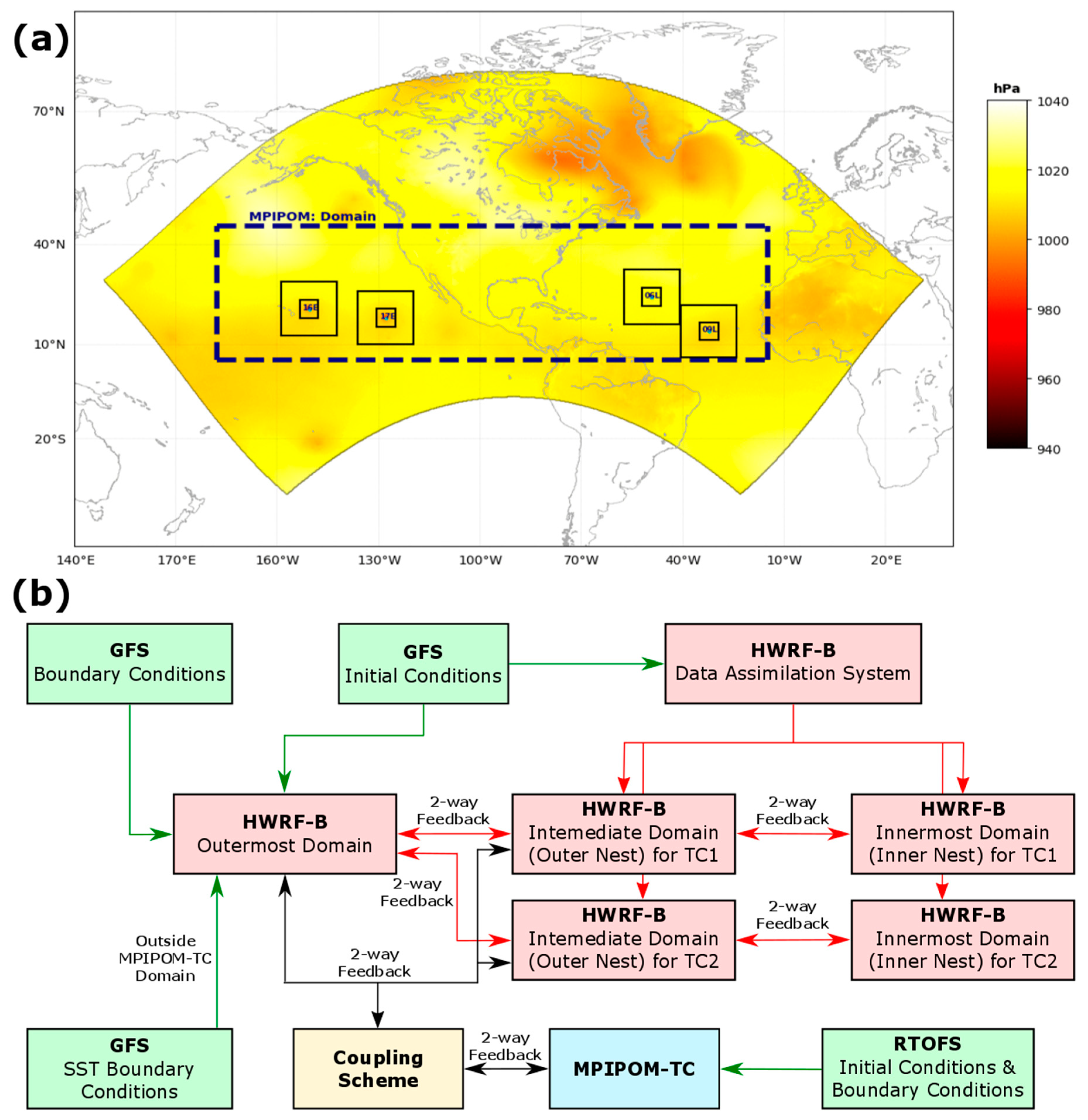
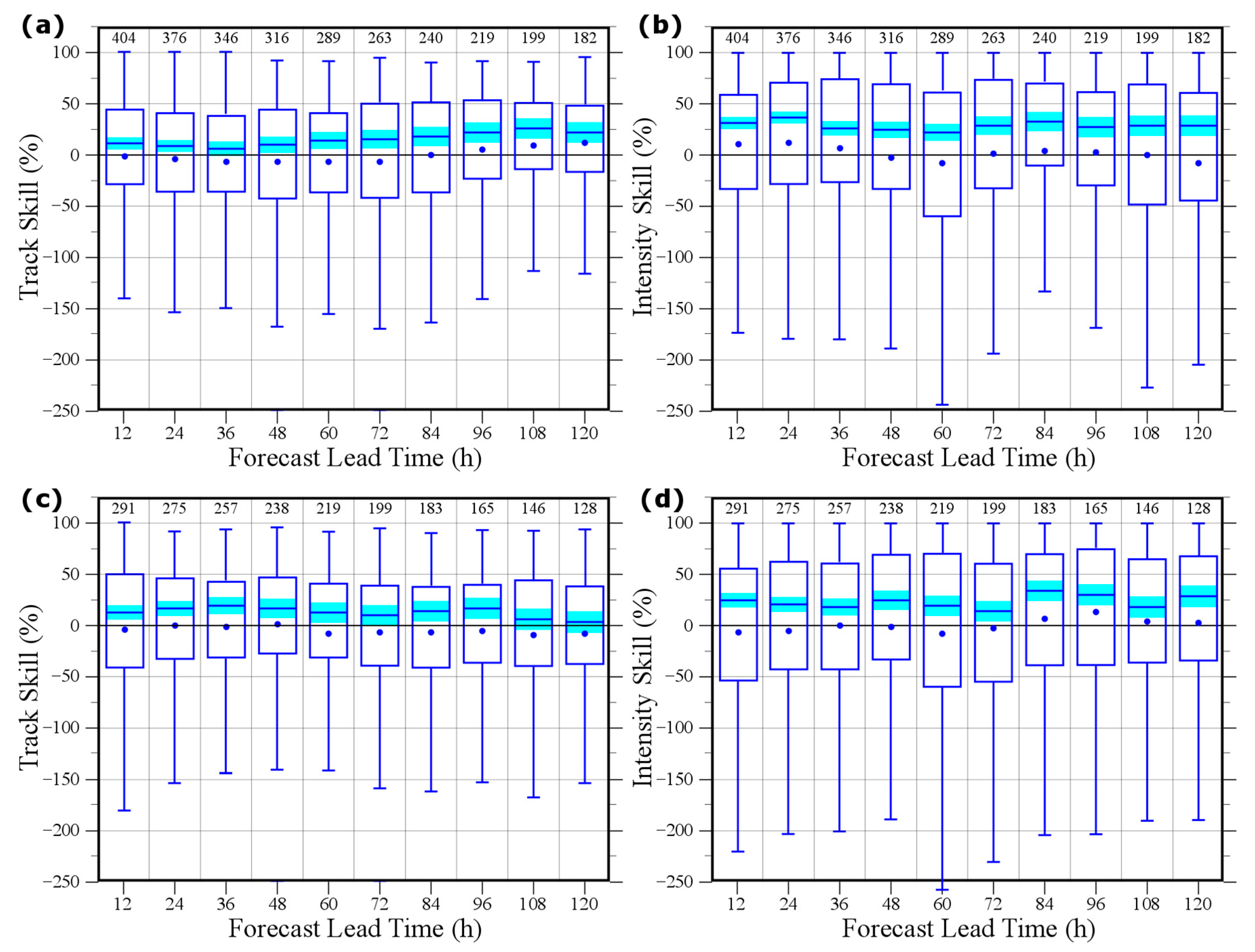
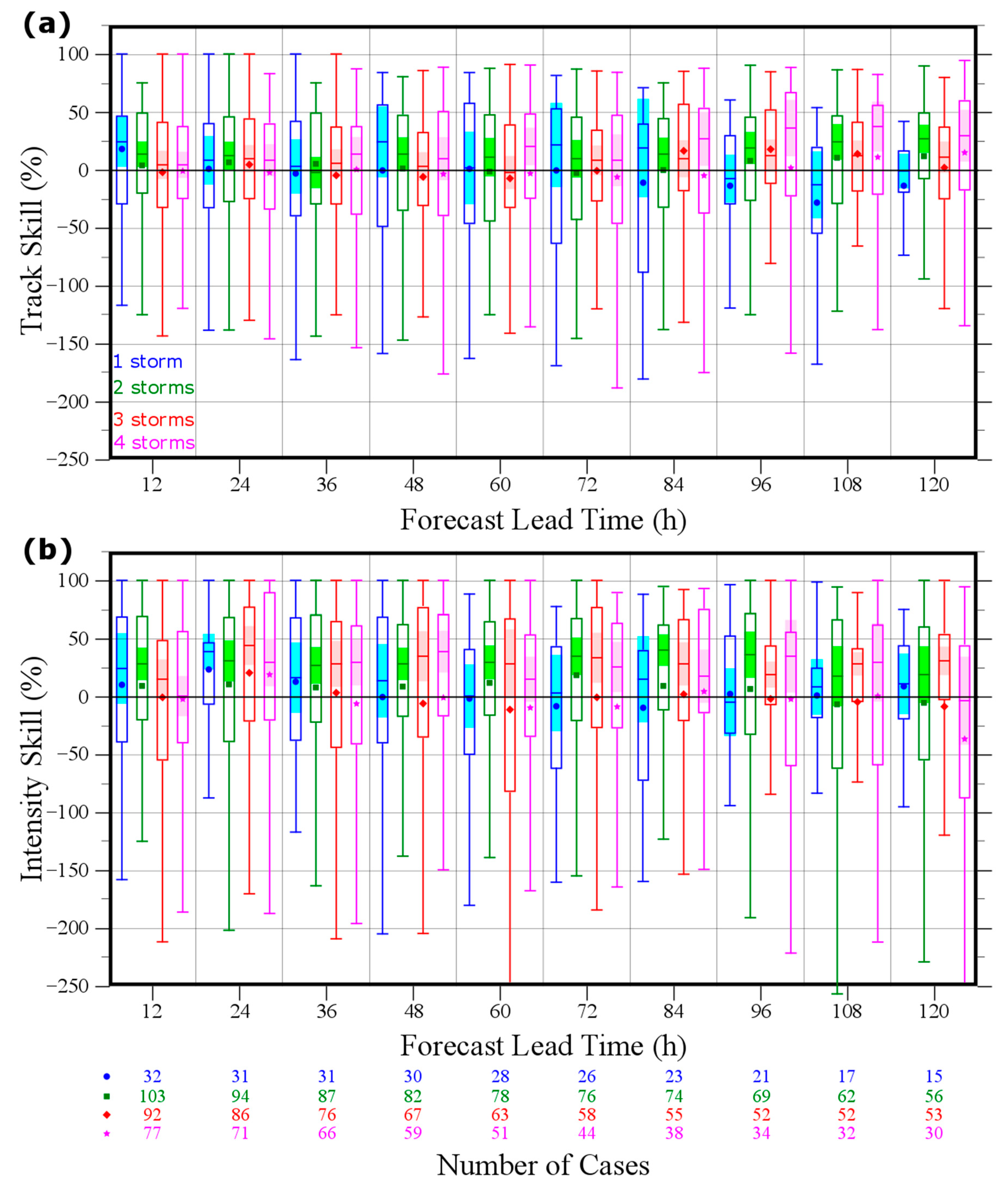
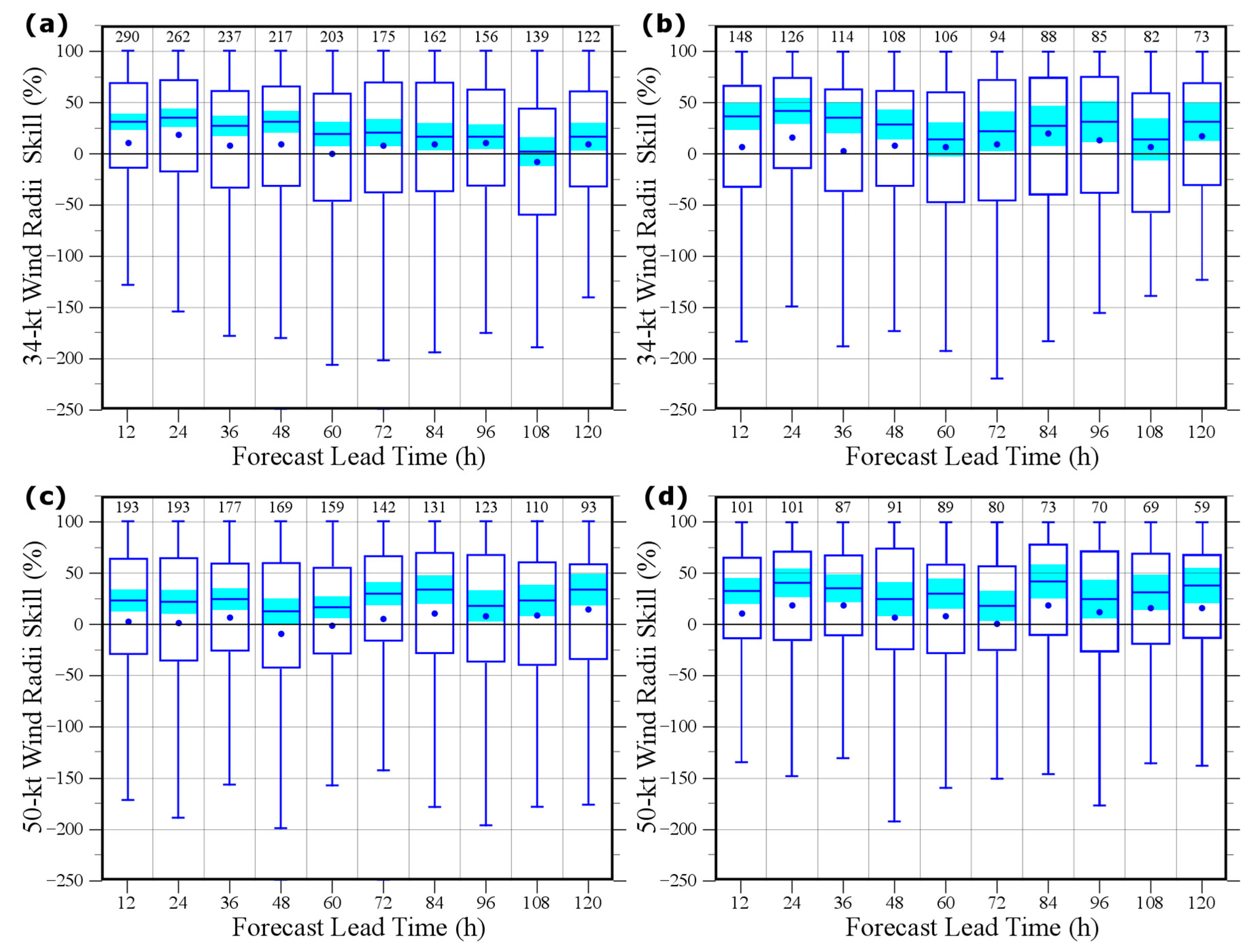
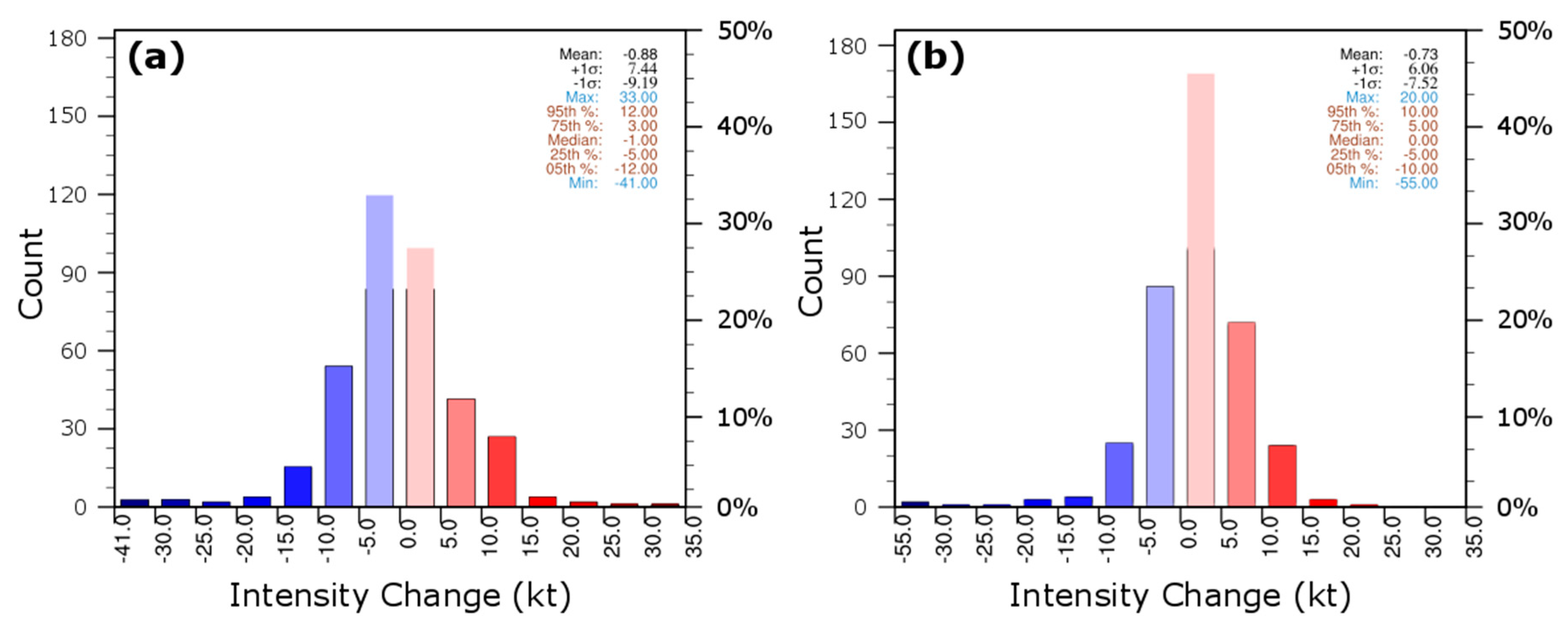
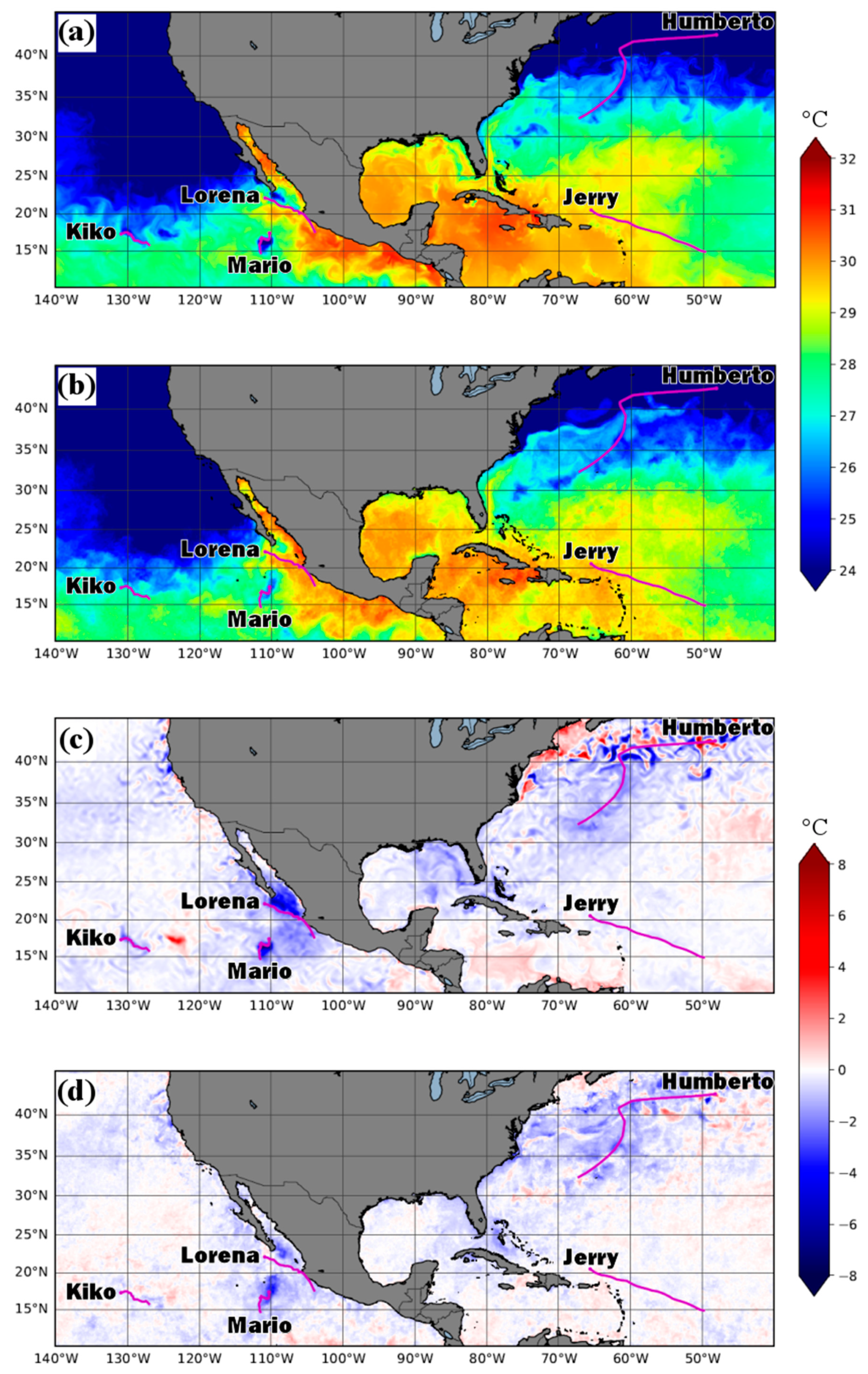
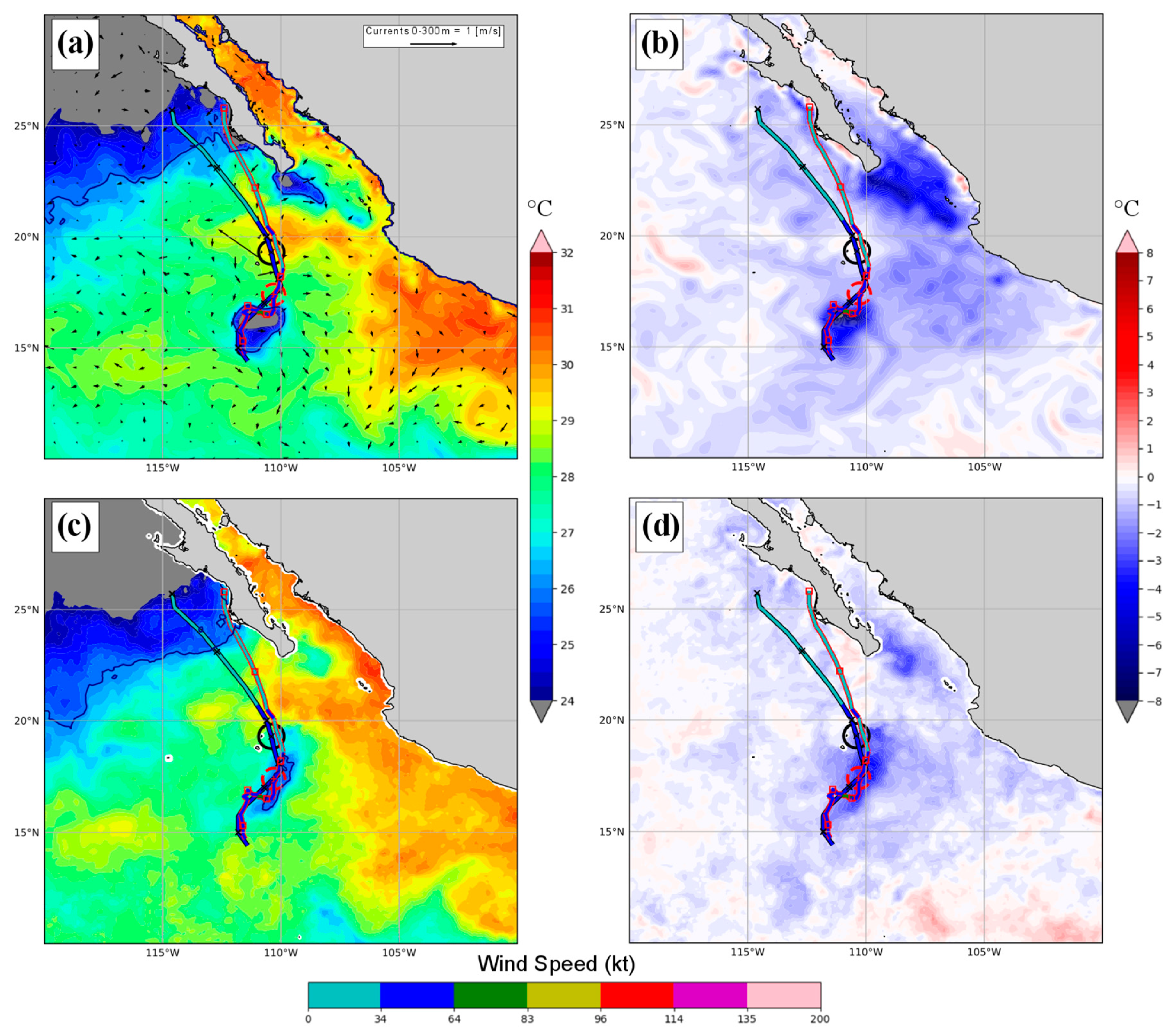
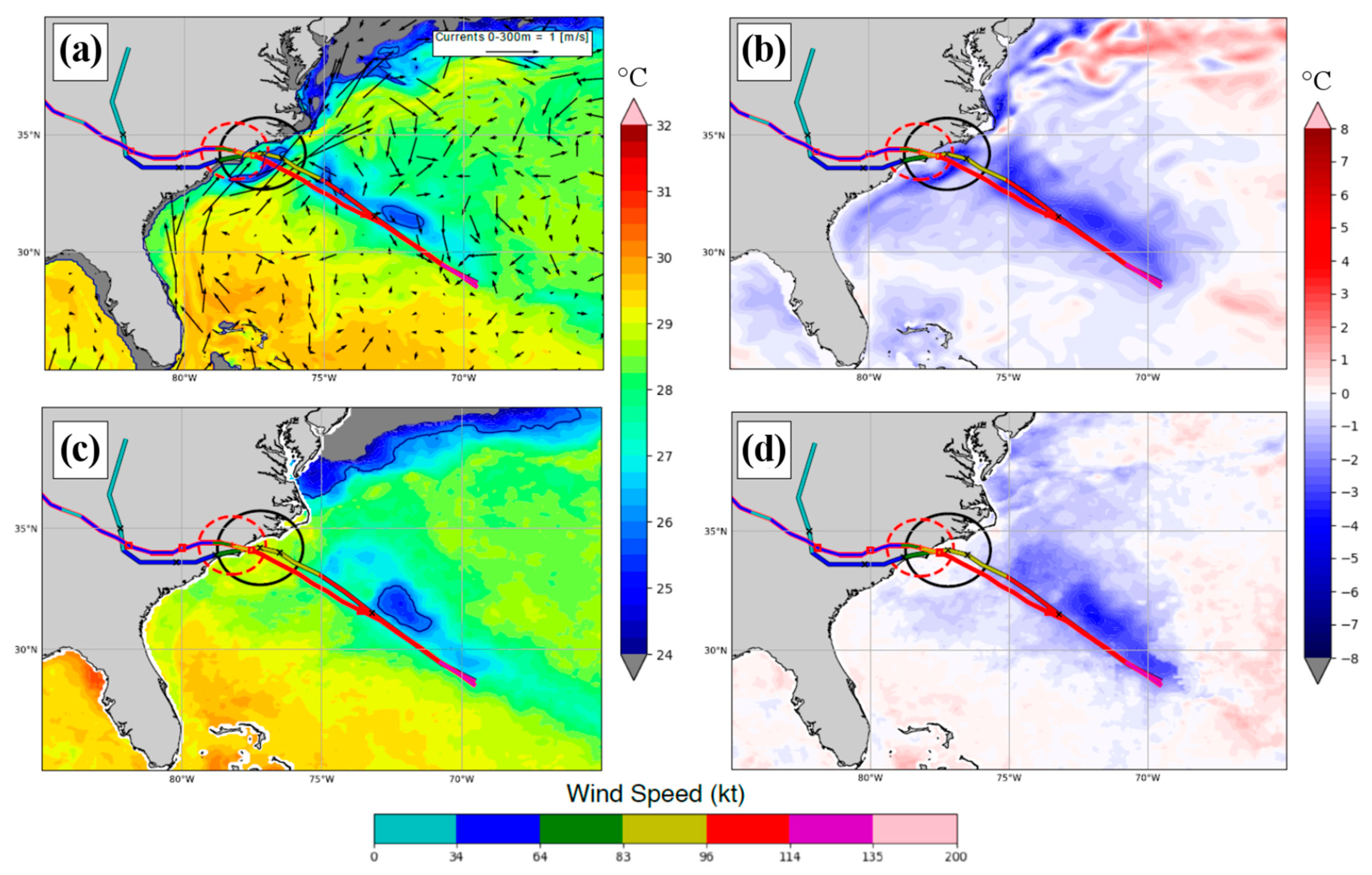
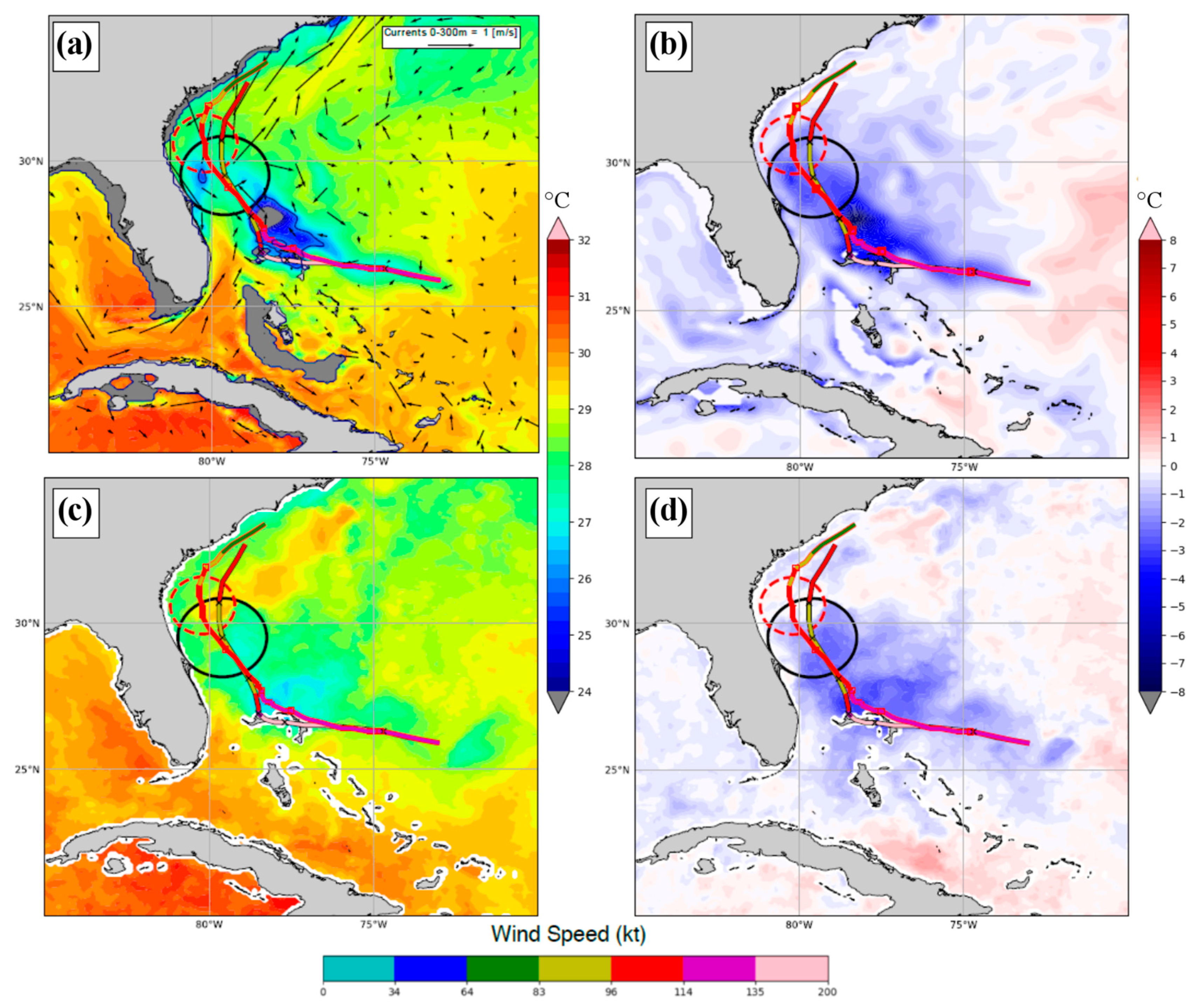
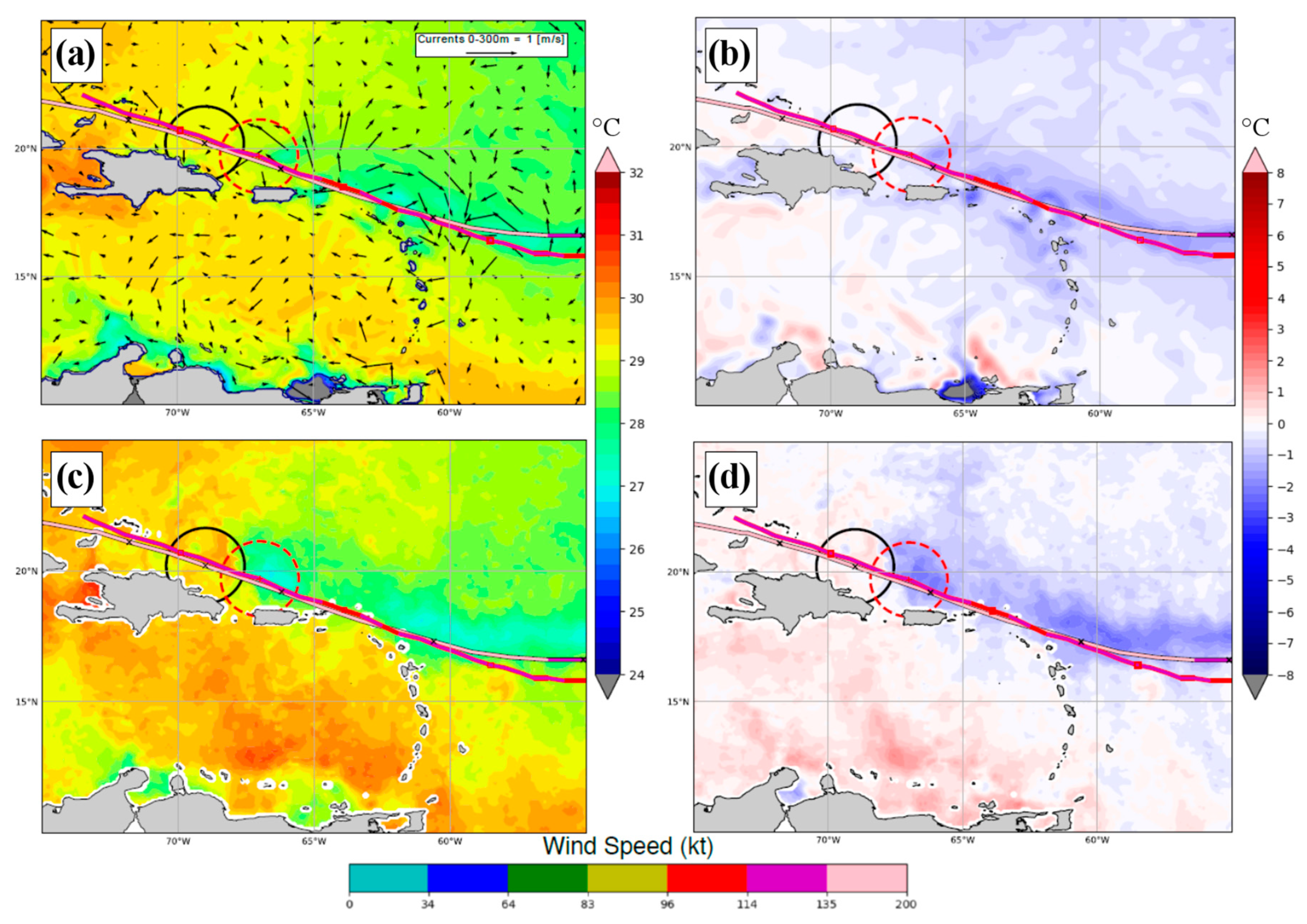
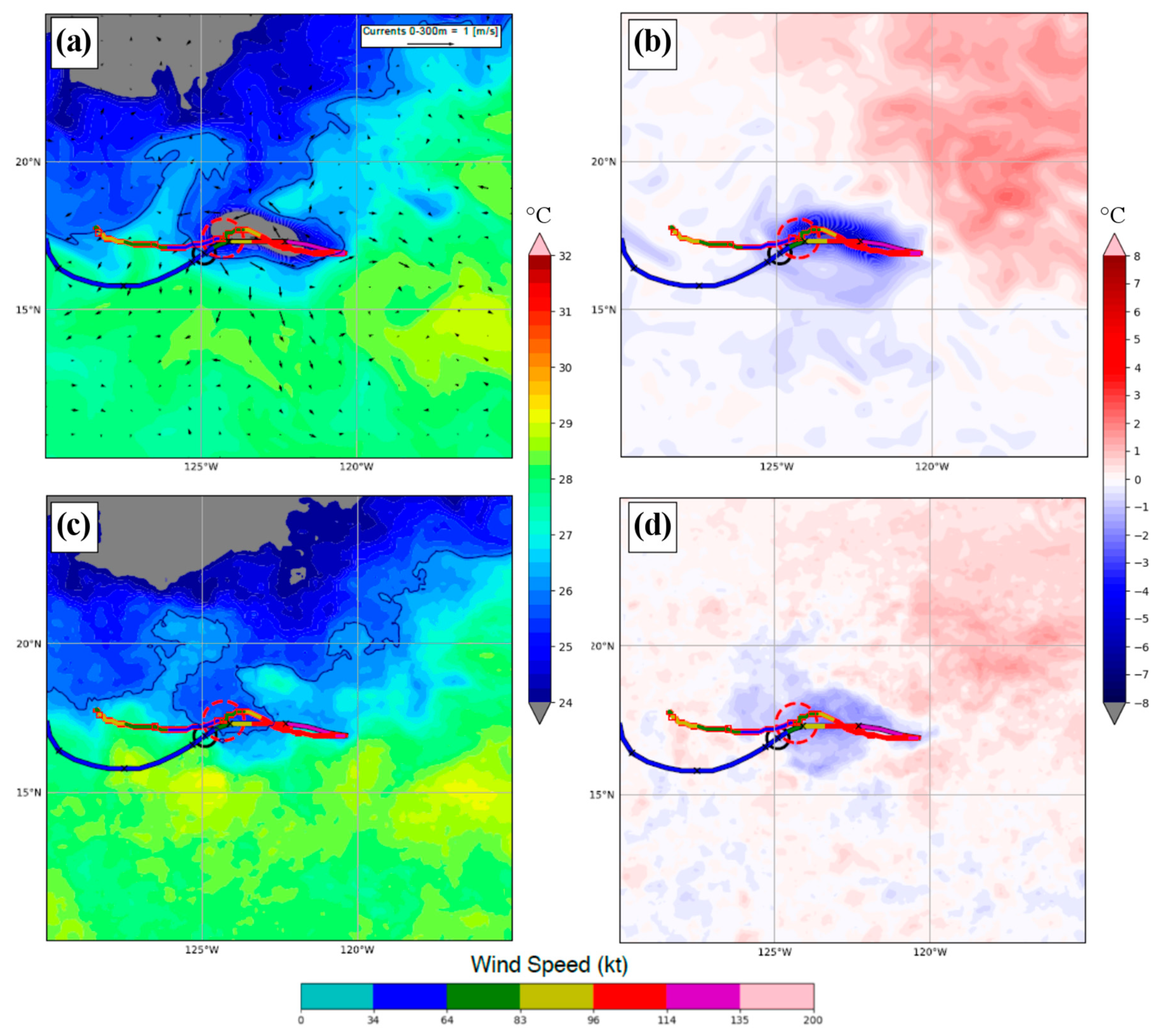
| Forecast Initialization Time | Storms with Nests |
|---|---|
| 1800 UTC 18 September 2019 | Kiko (EP132019), Lorena (EP152019), Mario (EP142019), Humberto (AL092019), Jerry (AL102019) |
| 0600 UTC 12 September 2018 | Florence (AL062018), Helene (AL082018), Isaac (AL092018), Olivia (EP172018), Paul (EP182018) |
| 1200 UTC 31 August 2019 | Dorian (AL052019), pre-Juliette (EP112019) |
| 1200 UTC 03 September 2017 | Irma (AL112017) |
| 0600 UTC 15 September 2019 | Kiko (EP132019), Humberto (AL092019) |
© 2020 by the authors. Licensee MDPI, Basel, Switzerland. This article is an open access article distributed under the terms and conditions of the Creative Commons Attribution (CC BY) license (http://creativecommons.org/licenses/by/4.0/).
Share and Cite
Alaka, G.J., Jr.; Sheinin, D.; Thomas, B.; Gramer, L.; Zhang, Z.; Liu, B.; Kim, H.-S.; Mehra, A. A Hydrodynamical Atmosphere/Ocean Coupled Modeling System for Multiple Tropical Cyclones. Atmosphere 2020, 11, 869. https://doi.org/10.3390/atmos11080869
Alaka GJ Jr., Sheinin D, Thomas B, Gramer L, Zhang Z, Liu B, Kim H-S, Mehra A. A Hydrodynamical Atmosphere/Ocean Coupled Modeling System for Multiple Tropical Cyclones. Atmosphere. 2020; 11(8):869. https://doi.org/10.3390/atmos11080869
Chicago/Turabian StyleAlaka, Ghassan J., Jr., Dmitry Sheinin, Biju Thomas, Lew Gramer, Zhan Zhang, Bin Liu, Hyun-Sook Kim, and Avichal Mehra. 2020. "A Hydrodynamical Atmosphere/Ocean Coupled Modeling System for Multiple Tropical Cyclones" Atmosphere 11, no. 8: 869. https://doi.org/10.3390/atmos11080869
APA StyleAlaka, G. J., Jr., Sheinin, D., Thomas, B., Gramer, L., Zhang, Z., Liu, B., Kim, H.-S., & Mehra, A. (2020). A Hydrodynamical Atmosphere/Ocean Coupled Modeling System for Multiple Tropical Cyclones. Atmosphere, 11(8), 869. https://doi.org/10.3390/atmos11080869






